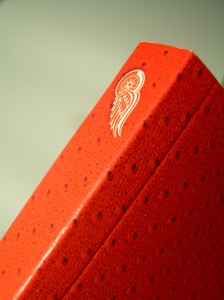 Tell a Perfect Binder Operator that he needs to bind a project containing two page forms or synthetic flysheets and he is likely to run for the hills, babbling incoherently. If your perfect binding project design requires the use of either two page forms or synthetic fly sheets, here are a few tips to help the project go smoothly, while allowing Perfect Binder Operators to maintain their sanity.
Tell a Perfect Binder Operator that he needs to bind a project containing two page forms or synthetic flysheets and he is likely to run for the hills, babbling incoherently. If your perfect binding project design requires the use of either two page forms or synthetic fly sheets, here are a few tips to help the project go smoothly, while allowing Perfect Binder Operators to maintain their sanity.
A two page form of any material is less stable and more difficult to feed and collate, on nearly any stock weight. Stock type and basis weight can exacerbate this challenge. A 50# basis weight text is the minimum that should be considered when a two page form must be planned when using offset or coated stocks. Below a 50# basis weight, the mechanical calipers on the collator, designed to detect a mis-feed or double feed, simply will not work. Mechanical calipers are not sensitive enough to detect a form this thin. Two page forms on stock weights less than 50# basis weight could be missed during the feeding process and not discovered. This results in missing pages in the final product. If you must include a two page form(s) in your perfect bound project, consider increasing the basis weight of the stock to at least 60#. The additional paper cost will go a long way toward avoiding the production of a book with missing pages. An alternative planning option is to combine the two page form with other signature page count options. For example, combine the two-page and a four page into a six page signature. Or, redesign a two page and an eight page form to create six page and four page signatures. Allied Bindery can help you get creative in your planning approach, while helping to minimize potential production and quality problems.
Synthetic stocks, often used for flysheets, create additional challenges. A basis weight of 30# will not only be too thin to detect through the pocket feeder calipers, but the stock itself will have a tendency to curl into a cylinder shape. The curling of thin, synthetic stock generally takes place immediately after the flat cutting process. Curled stock simply will not feed through a collator pocket. The curling sequence can take place so rapidly that the synthetic sheet will often curl between the collator pocket and the binder. When this phenomenon occurs, the sheet will likely be bound crookedly into the spine of the book. Allied Bindery recommends synthetic stocks with a minimum basis weight of 32# to minimize the potential for curling.